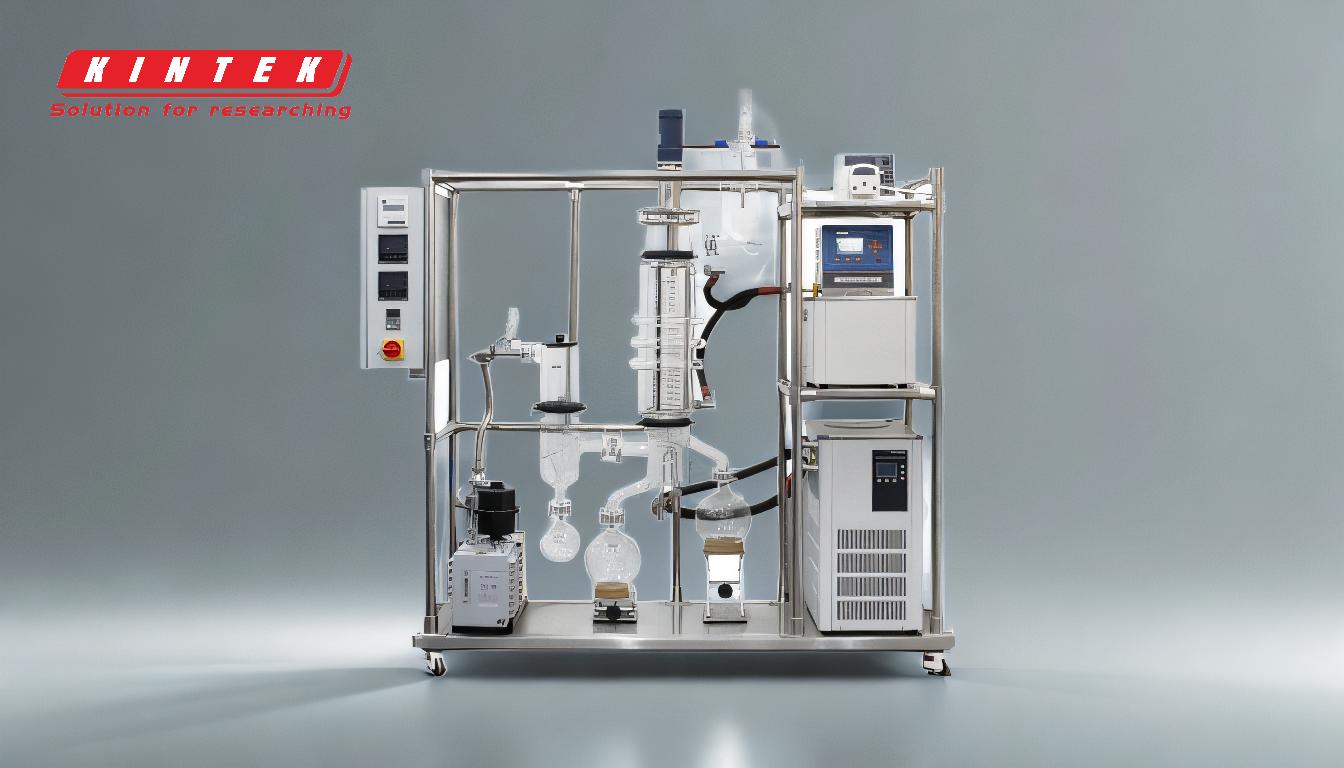Molecular distillation is a specialized vacuum distillation process designed for separating thermally sensitive and high molecular weight materials. It operates under extremely low pressures (≈ 0.01 torr) to ensure the mean free path of molecules exceeds the distance between the evaporation and condensation surfaces. This allows for efficient separation of components based on their evaporation rates. The equipment typically includes a heating vessel, condensing surface, vacuum system, and feeding and collection mechanisms. The process is particularly useful for purifying natural products, complex molecules, and materials prone to thermal degradation.
Key Points Explained:

-
Operating Principle of Molecular Distillation:
- Molecular distillation operates under a high vacuum (≈ 0.01 torr), ensuring the mean free path of molecules is greater than the distance between the evaporation and condensation surfaces.
- This setup allows light molecules to travel to the condensing surface and condense, while heavier molecules return to the liquid phase, achieving separation.
-
Key Components of Molecular Distillation Equipment:
- Heating Vessel: A jacketed vessel with wipers attached to the walls, heated to facilitate evaporation.
- Condenser: A surface placed close to the heating plate to condense light molecules.
- Vacuum System: High-performance vacuum pumps maintain the low pressure required for the process.
- Feeding System: A gear pump ensures constant and automatic feeding of the mixture.
- Collection System: Separate units collect the distillate (light molecules) and residue (heavy molecules).
-
Process Flow in Molecular Distillation:
- The mixture is introduced at the top of the heating vessel and flows downward along the heating plate.
- Upon heating, both light and heavy molecules escape into the gas phase.
- Light molecules, with a larger free path, reach the condensing surface, condense, and are collected as distillate.
- Heavy molecules, with a smaller free path, do not reach the condensing surface, return to the liquid phase, and are collected as residue.
-
Applications of Molecular Distillation:
- Separation, purification, and concentration of natural products (e.g., essential oils, vitamins).
- Processing thermally sensitive materials (e.g., cannabinoids, high molecular weight compounds).
- Purification of complex molecules in pharmaceuticals and specialty chemicals.
-
Advantages of Molecular Distillation:
- Operates at low temperatures, minimizing thermal degradation of sensitive materials.
- High separation efficiency due to the short distance between evaporation and condensation surfaces.
- Suitable for high molecular weight and high boiling point compounds.
-
Safety Considerations:
- The process involves handling flammable materials under high vacuum, requiring careful design and operation to prevent explosion risks.
- Proper cooling systems and vacuum maintenance are essential to ensure safe and efficient operation.
-
Comparison with Short-Path Distillation:
- Molecular distillation and short-path distillation are essentially the same process, characterized by high vacuum and close proximity of evaporation and condensation surfaces.
- Both are used for similar applications, particularly in the purification of thermally sensitive and high molecular weight materials.
By understanding the structure and operation of molecular distillation, equipment and consumable purchasers can make informed decisions about its suitability for specific applications, ensuring optimal performance and safety.
Summary Table:
| Aspect | Details |
|---|---|
| Operating Principle | High vacuum (≈ 0.01 torr) ensures molecules' mean free path exceeds distance between surfaces. |
| Key Components | Heating vessel, condenser, vacuum system, feeding system, collection system. |
| Process Flow | Mixture flows downward, light molecules condense, heavy molecules return. |
| Applications | Purification of natural products, thermally sensitive materials, and complex molecules. |
| Advantages | Low-temperature operation, high separation efficiency, suitable for high molecular weight compounds. |
| Safety Considerations | Requires careful handling of flammable materials and proper cooling systems. |
| Comparison | Similar to short-path distillation, used for sensitive and high molecular weight materials. |
Discover how molecular distillation can optimize your processes—contact us today for expert advice!














